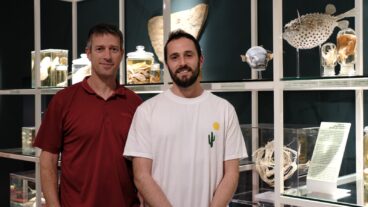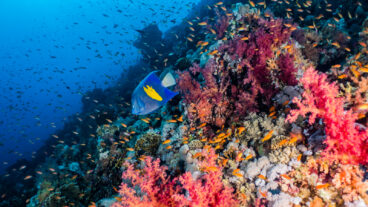There may be a revolution blowing our way: The Israeli company Seambiotic has found a way to produce biofuel by channeling smokestack carbon dioxide emissions through pools of algae that clean it. The growing algae thrives on the added nutrients, and become a useful biofuel.
For the last two years, the company has done something that other alternative fuel companies have dreamt about and are only starting to do now: they’ve tested their idea with an electric utility company – a coal-burning power plant in the southern city of Ashkelon operated by the Israel Electric Company (IEC).
Looking high into the sky, it is far too obvious how badly power plants and factories are polluting our environment. One of the most worrying gases produced by power plants today is carbon dioxide, which is believed responsible for global warming.
In Israel, as in the US and the rest of the world, it is estimated that power plants produce about 40% of all greenhouse gases. By employing tactics designed by nature, however, Seambiotic believes it can lock up carbon dioxide emissions through a process called biofixation. And they have employed a slimy plant from the algae family to do the job.
Algae are marine-derived plants that thrive on carbon dioxide and sunlight.
“Algae grow fast and continuously,” says Seambiotic CEO Amnon Bechar. “An algal pond can produce oil 365 days a year and much more oil per hectare of land than traditional plant crops.”
Studies have shown that algae may be one of the world’s most promising biofuels. It is capable of producing 30 times more oil per acre than the current crops used for the production of biofuels; algae biofuel is non-toxic, contains no sulfur, and is highly biodegradable.
The company’s prototype algae farm in Ashkelon uses the tiny plants to suck up carbon dioxide emissions from power plants. Seambiotic’s eight shallow algae pools, covering about a quarter-acre, are filled with the same seawater used to cool the power plant. A small percentage of gases are siphoned off from the power plant flue and are channeled directly into the algae ponds.
Originally when the prototype started operating, a common algae called nannochloropsis was culled from the sea and used in the ponds. Within months, the research team noticed an unusual strain of algae growing in the pools – skeletonema – a variety believed to be very useful for producing biofuel.
According to Noam Menczel, Seambiotic’s director of investor relations, the company’s developments have stirred interest around the world, specifically in Brazil, which has become one of the champions of R&D in the area of alternative and renewable fuels.
“A Brazilian professor wrote to us recently, ‘if that algae of yours has the better features as you say it does, we will close our sugar cane operations and switch to algae,'” said Menczel.
If all goes according to plan, Seambiotic plans to build its first large-scale biofuel reactor by next year and hopes to do so with a large international partner. Several potentials are already knocking on the door.
Menczel reports that Seambiotic is meeting with electric plant operators from Hawaii, Singapore, Italy and India, all keen on hearing about Seambiotic’s technology.
“As we have already developed and produced algae through the process, our main goal is to market the installation and development of our unique algae growing system around the world,” notes Menczel, who adds that Seambiotic’s approach includes a special system to filter out heavy smoke.
IEC senior engineer Gabriel Jinjikhashvily says that besides offering their coal-burning site as a pilot plant for Seambiotic, the power station also lends its know-how to help fulfill the company’s dream. And in return, the IEC is getting some vital experience from Seambiotic.
Recently, the IEC became part of a European consortium, working with universities from Holland, Germany and France, aimed at developing new water technologies in the scope of climate change – project GLOWA ‘Global Change in the Hydrological Cycle’.
“Seambiotic provided an opportunity for us to test the applicability of membranes [gas filters] developed by our European consortium, where we aim to separate carbon dioxide from the other flue gases,” said Jinjikhashvily.
“The greatest problem today when dealing with carbon dioxide emissions is separating them from the other gases. The target of this multi-national group is to develop new membranes that are both cheap and efficient,” he added.
According to Seambiotic’s CEO Bechar: “By raising the level of carbon dioxide emissions in the water we increased the yield [of algae] one million-fold compared to the natural state in the sea.”
While Seambiotic’s approach may be novel, using algae for biofuel or “biofixation” is not a new idea. An Israeli scientist now in the US had a similar idea for cleaning emissions and joined US-based GreenFuel some time ago. Earlier this year, GreenFuel announced that it would be building a prototype for a Louisiana power plant in New Roads. But current reports on funding issues, suggests that the fate of this project is not clear.
When the project was announced David Crane, the CEO of the Louisiana plant said: “Coal is – and will remain – the premier domestic fuel source for power generation purposes in the United States for the foreseeable future. This means it is incumbent on us not only to build new coal plants using technology which limits or eliminates greenhouse gas emissions but also to find the best way to retrofit the country’s existing fleet of coal plants for post-combustion carbon capture.”
John Laumer, an environmental consultant from Philadelphia and a writer for TreeHugger.com thinks that algal farming, when it aligns closely to that found in nature, will give the most promising results.
“The use of cooling ponds and other artificial, shallow impoundments; and to learn how to cultivate and harvest sequential blooms. This is the path that will be proven economical and environmentally acceptable,” he says.
This appears to be the approach taken by Seambiotic, which has modestly spent only $2 million on R&D funding up until now. Knowing how to use investment money, concludes Menczel, is the strength of Israeli entrepreneurs:
“This is Israeli ingenuity for you – knowing how to conserve investor dollars. In Israel, we have creative ways for taking short cuts and don’t always live by the rules. This approach allows us to do much more with much less resources.”
In the context of climate change and a future energy crisis, let’s hope Seambiotic uses its creativity and resources to make algae the next big thing. Perhaps even one day, the slimy green stuff that we scrape off of our boats and fish tanks, may be worth as much as gold.












